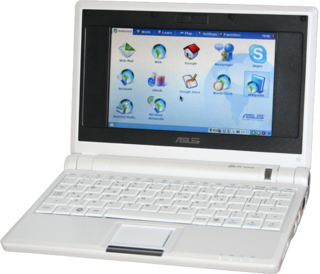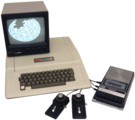
Amiga is a family of personal computers introduced by Commodore in 1985. The original model is one of a number of mid-1980s computers with 16- or 16/32-bit processors, 256 KB or more of RAM, mouse-based GUIs, and significantly improved graphics and audio compared to previous 8-bit systems. These systems include the Atari ST—released earlier the same year—as well as the Macintosh and Acorn Archimedes. Based on the Motorola 68000 microprocessor, the Amiga differs from its contemporaries through the inclusion of custom hardware to accelerate graphics and sound, including sprites and a blitter, and a pre-emptive multitasking operating system called AmigaOS.

Atari ST is a line of personal computers from Atari Corporation and the successor to the Atari 8-bit family. The initial model, the Atari 520ST, had limited release in April–June 1985, and it was widely available in July. The ST was the first personal computer with a bitmapped color graphical user interface, using a version of Digital Research's GEM interface / operating system, from February 1985.

In computing, an expansion card is a printed circuit board that can be inserted into an electrical connector, or expansion slot on a computer's motherboard to add functionality to a computer system. Sometimes the design of the computer's case and motherboard involves placing most of these slots onto a separate, removable card. Typically such cards are referred to as a riser card in part because they project upward from the board and allow expansion cards to be placed above and parallel to the motherboard.

IceWM is a stacking window manager for the X Window System, originally written by Marko Maček. It was written from scratch in C++ and is released under the terms of the GNU Lesser General Public License. It is customizable, relatively lightweight in terms of memory and CPU usage, and comes with themes that allow it to imitate the GUI of Windows 95, Windows XP, Windows 7, OS/2, Motif, and other graphical user interfaces.

The CDTV is a home multimedia entertainment and video game console – convertible into a full-fledged personal computer by the addition of optional peripherals – developed by Commodore International and launched in April 1991.
In computing, instant-on is the ability to boot nearly instantly, allowing to go online or to use a specific application without waiting for a PC's traditional operating system to launch. Instant-on technology is today mostly used on laptops, netbooks, and nettops because the user can boot up one program, instead of waiting for the PC's operating system to boot. This allows a user to launch a single program, such as a movie-playing program or a web browser, without the need of the whole operating system. There still remain a few true instant-on machines such as the Atari ST, as described in the Booting article. These machines had complete Operating Systems resident in ROM similar to the way in which the BIOS function is conventionally provided on current computer architectures. The "instant-on" concept as used here results from loading an OS, such as a legacy system DOS, with a small hard drive footprint. Latency inherent to mechanical drive performance can also be eliminated by using Live USB or Live SD flash memory to load systems at electronic speeds which are orders of magnitude faster.

The Commodore 64 home computer used various external peripherals. Due to the backwards compatibility of the Commodore 128, most peripherals would also work on that system. There is also some compatibility with the VIC-20 and Commodore PET.

Asus Eee is a family of products by AsusTek Computer Inc. The product family began with the release of the Eee PC subnotebook in 2007; since then, the product family has diversified into a number of PC form factors. According to the company, the name Eee derives from "the three Es," an abbreviation of its advertising slogan for the device: "Easy to learn, Easy to work, Easy to play".

The ASUS Eee PC is a netbook computer line from Asus, and a part of the ASUS Eee product family. At the time of its introduction in late 2007, it was noted for its combination of a lightweight, Linux-based operating system, solid-state drive (SSD), and relatively low cost. Newer models added the options of Microsoft Windows operating system and rotating media hard disk drives (HDD), and initially retailed for up to 500 euros.

The history of the personal computer as a mass-market consumer electronic device began with the microcomputer revolution of the 1970s. A personal computer is one intended for interactive individual use, as opposed to a mainframe computer where the end user's requests are filtered through operating staff, or a time-sharing system in which one large processor is shared by many individuals. After the development of the microprocessor, individual personal computers were low enough in cost that they eventually became affordable consumer goods. Early personal computers – generally called microcomputers – were sold often in electronic kit form and in limited numbers, and were of interest mostly to hobbyists and technicians.
These tables provide a comparison of netbooks.

A personal computer, often referred to as a PC, is a computer designed for individual use. It is typically used for tasks such as word processing, internet browsing, email, multimedia playback, and gaming. Personal computers are intended to be operated directly by an end user, rather than by a computer expert or technician. Unlike large, costly minicomputers and mainframes, time-sharing by many people at the same time is not used with personal computers. The term home computer has also been used, primarily in the late 1970s and 1980s. The advent of personal computers and the concurrent Digital Revolution have significantly affected the lives of people in all countries.

The Amiga 1200, or A1200, is a personal computer in the Amiga computer family released by Commodore International, aimed at the home computer market. It was launched on October 21, 1992, at a base price of £399 in the United Kingdom and $599 in the United States.
Nvidia Ion was a product line of Nvidia Corporation intended for motherboards of low-cost portable computers. It used graphics processing units and chipsets intended for small products.

Home computers were a class of microcomputers that entered the market in 1977 and became common during the 1980s. They were marketed to consumers as affordable and accessible computers that, for the first time, were intended for the use of a single, non-technical user. These computers were a distinct market segment that typically cost much less than business, scientific, or engineering-oriented computers of the time, such as those running CP/M or the IBM PC, and were generally less powerful in terms of memory and expandability. However, a home computer often had better graphics and sound than contemporary business computers. Their most common uses were word processing, playing video games, and programming.

Commodore USA, LLC was a computer company based in Pompano Beach, Florida, with additional facilities in Fort Lauderdale, Florida. Commodore USA, LLC was founded in April 2010. The company's goal was to sell a new line of PCs using the classic Commodore and Amiga name brands of personal computers, having licensed the Commodore brand from Commodore Licensing BV on August 25, 2010 and the Amiga brand from Amiga, Inc. on August 31, 2010.

ASUSTeK Computer Inc. is a Taiwanese multinational computer, phone hardware and electronics manufacturer headquartered in Beitou District, Taipei, Taiwan. Its products include desktop computers, laptops, netbooks, mobile phones, networking equipment, monitors, Wi-Fi routers, projectors, motherboards, graphics cards, optical storage, multimedia products, peripherals, wearables, servers, workstations and tablet PCs. The company is also an original equipment manufacturer (OEM).

The Atari joystick port is a computer port used to connect various gaming controllers to game console and home computer systems in the 1970s to the 1990s. It was originally introduced on the Atari 2600 in 1977 and then used on the Atari 400 and 800 in 1979. It went cross-platform with the VIC-20 in 1981, and was then used on many following machines from both companies, as well as a growing list of 3rd party machines like the MSX platform and various Sega consoles.
The Olivetti company, an Italian manufacturer of computers, tablets, smartphones, printers and other such business products as calculators and fax machines, was founded as a typewriter manufacturer by Camillo Olivetti in 1908 in the Turin commune of Ivrea, Italy. Olivetti was a pioneer in computer development, starting with the mainframe systems in the 1950s, and continuing into the 1990s with PC-compatible laptops and desktops.


























